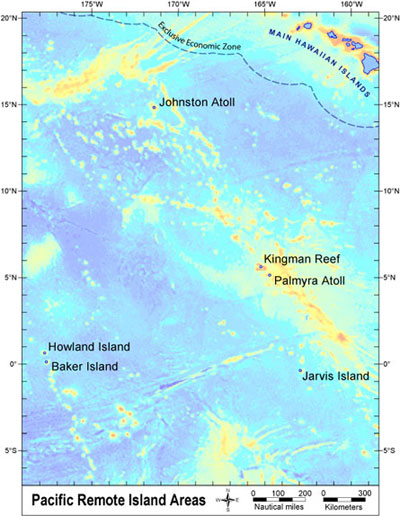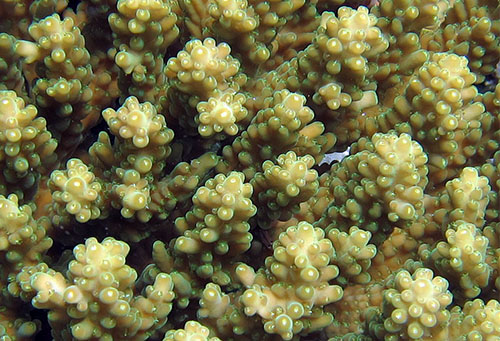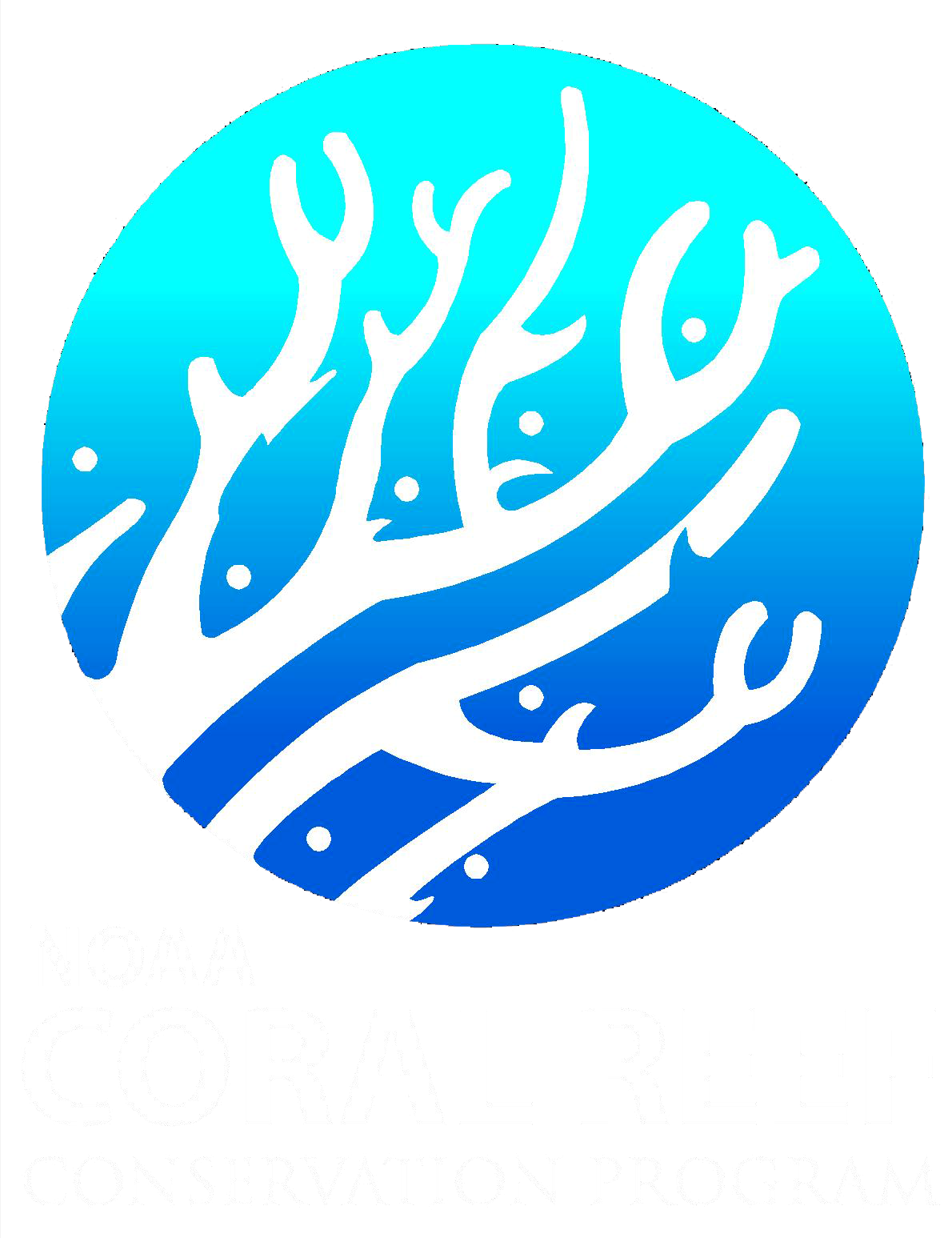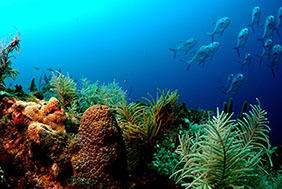-
Home
-
Data & Publications
-
Regional Portals
- About Regional Portals
- Florida
- Navassa Island
- Puerto Rico
- Flower Garden Banks
- U.S. Virgin Islands
- American Samoa
- Commonwealth of the Northern Mariana Islands
- Federated States of Micronesia
- Guam
- Main Hawaiian Islands
- Republic of the Marshall Islands
- Northwestern Hawaiian Islands
- Republic of Palau
- Pacific Remote Island Areas
-
CRCP Activities
- Glossary
U.S. Pacific Remote Island Area (PRIA)
The U.S. Pacific Remote Island Area (PRIA) includes seven islands, atolls and reefs in the Central Pacific that are under the jurisdiction of the United States. Baker, Howland and Jarvis islands, Johnston Atoll, Palmyra Atoll (owned by the Nature Conservancy), and Kingman Reef lie between Hawai‘i and American Samoa. Wake Island is located between the Northwestern Hawaiian Islands and Guam. Wake Island is an unincorporated territory of the U.S. that is administered by the Department of the Interior (DOI) and the U.S. Air Force. All except Wake Island and Johnston Atoll are administered as National Wildlife Refuges (NWR) by the U.S. Fish and Wildlife Service (USFWS) of the DOI. Johnston Atoll is managed by the Department of Defense (DOD). Wake Island is under the jurisdiction of DOI, and managed by DOD.
Some sources include Rose Atoll (the easternmost of the Samoan Islands) and Midway Atoll (located near the northern end of the Northwestern Hawaiian Islands) among PRIA.
The U.S. claimed most of these uninhabited islands under the Guano Act of 1856. In the absence of human activities, the coral reef ecosystems of PRIA remained undisturbed until the early 20th century. During World War II, the U.S. constructed and occupied military bases at Johnston and, Palmyra Atolls, Wake Island, Midway Atoll, and Baker Island. Jarvis and Howland Islands were also briefly occupied or utilized during the war. With the closure of the military base at Johnston Atoll in 2004, only Wake Island remains an active U.S. military base.
Even today, all of PRIA has escaped coral reef ecosystem degradation caused by coastal development, associated pollutants, and major shipping lanes. Public entry to the islands is by special-use permit from the USFWS only and generally restricted to scientists and educators. Only Midway and Palmyra Atolls have serviceable runways; Baker Island, Howland Island, and Johnston Atoll no longer have functional airstrips.

Pacific Remote Island Areas location map
More Photos
Highlights
Coral Reef Condition: A Status Report for the Pacific Remote Islands (2018)
Publications
Status of Coral Reefs of the Pacific and Outlook: 2011
Executive orders, Secretarial Orders, and Congressional Acts
Report on the Status of Marine Protected Areas in Coral Reef Ecosystems of the United States. Volume 1: Marine Protected Areas Managed by U.S. States,Territories, and Commonwealths. NOAA Technical Memorandum CRCP 2 February 2007
Field Identification Guide to the Threatened Corals of the U.S. Pacific Islands

A close-up of A. retusa which can be found in U.S. Pacific Coral Reef Jurisdictions. Copyright Douglas Fenner.
Status Reports
Coral Reef Condition: A Status Report for the Pacific Remote Islands (2018)
State of The Reefs Report (SOTR)
The State of Coral Reef Ecosystems of the United States and Pacific Freely Associated States: 2008.
The State of Coral Reef Ecosystems of the United States and Pacific Freely Associated States: 2005.
The State of Coral Reef Ecosystems of the United States and Pacific Freely Associated States: 2002.
Metadata, Data and Publications Search in CoRIS
Search the CoRIS Geoportal for U.S. Pacific Remote Island Areas (PRIAS) metadata, data and publications.
You may also enter the name of any atoll, island or reef in the CoRIS Geoportal search box and press the "Search" button.
ReefBase Coral Bleaching Reports
Select " U.S. Pacific Islands" in the Region window and select the name of the atoll, island, or reef in the Country window
Near-Real Time Monitoring Data
Coral Reef Watch Satellite Monitoring
Coral Reef Watch - Wake Atoll, Johnston Atoll, and Howland and Baker Atoll Virtual Stations
The Global Temperature-Salinity Profile Program
NOAA CO-OPS - Tide Data
Other Data
Pacific Islands Benthic Habitat Mapping Center - Pacific Remote Island Areas data
Benthic Habitat Mapping of Palmyra Atoll
Education and Outreach
Pacific Remote Islands Marine National Monument
Pacific Islands Fish And Wildlife Office
Marine Protected Areas/Marine Managed Areas
Marine Protected Areas of the United States Home Page
The Marine Protected Areas Inventory
Marine Federal Areas Fact Sheet
Executive order 13158: Marine Protected Areas
Baker Island National Wildlife Refuge
Howland island National Wildlife Refuge
Jarvis Island National Wildlife Refuge
Johnston Island National Wildlife Refuge
Kingman Reef National Wildlife Refuge
Pacific Remote Islands Marine National Monument








